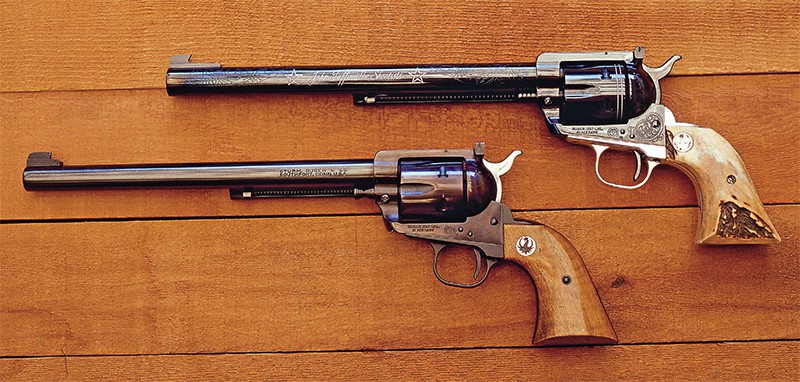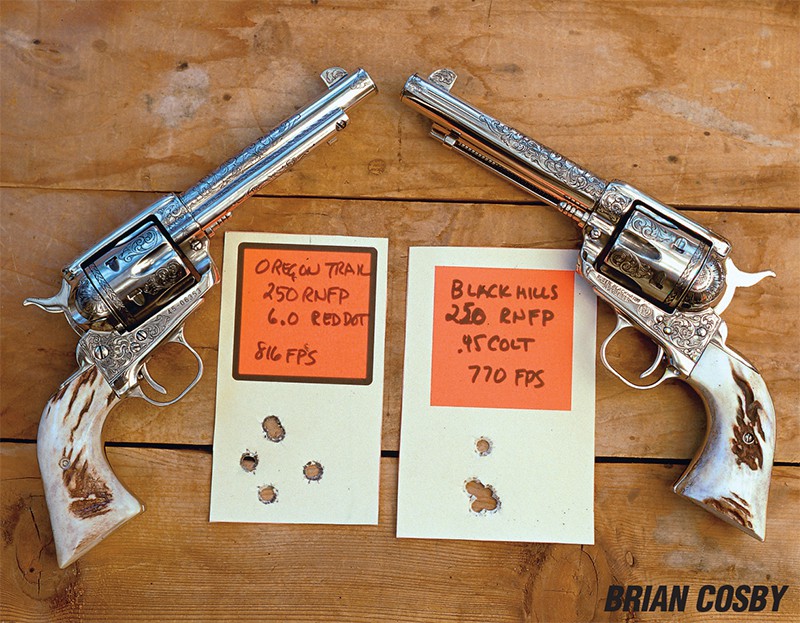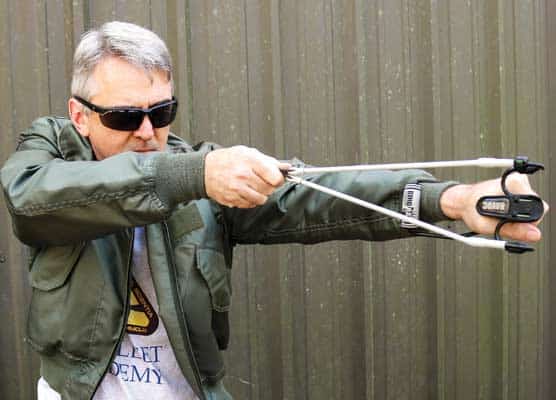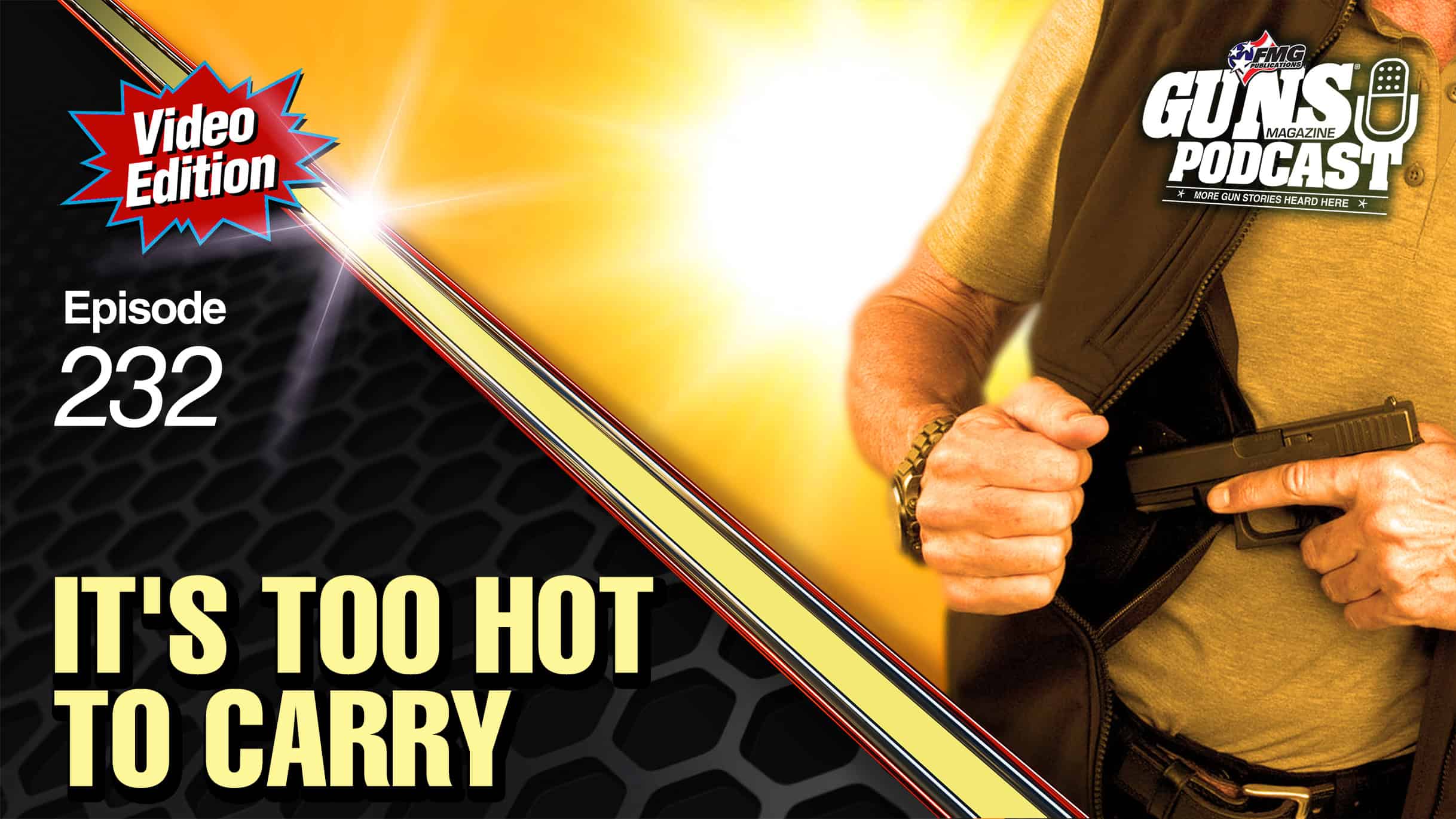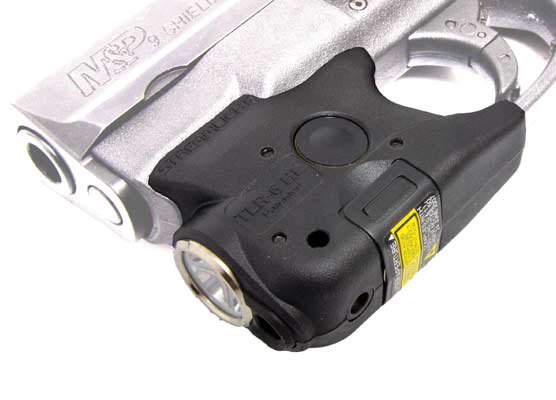Customizing The Ruger Old Model Revolver
We live in an imperfect world. If things were perfect Bill Ruger would have introduced his .357 Magnum Blackhawk earlier than 1955 and it would have been allowed to follow a natural path into other calibers before the .44 Magnum arrived so quickly in 1956. But alas, such was not to be.
Ruger’s first centerfire sixgun was a study in near perfection. As a teenager, Bill had obviously spent time in the pages of the American Rifleman studying the custom Colt Single Actions often pictured. When it came time to produce the Blackhawk, Ruger reached back and incorporated such ideas as a flat-topped frame and adjustable sights he had seen on those early custom Colts.
The Ruger Blackhawk was almost perfect. However to save production costs, the grip frame was of one-piece aluminum instead of the blued steel that would have moved it closer to perfection. In 1955, the .357 Magnum was the most powerful cartridge available, however then as now, big bore sixgunners preferred the .44 Special and the .45 Colt. Ruger planned to offer his new Blackhawk in these two big bore chamberings, however something happened to stop those plans.
There are two versions of the story and you may pick which one you care to believe. One says a Ruger employee found a cartridge case marked “.44 Magnum” in Remington’s trash. The question naturally arises as to what he was doing there. A second more believable version is that of a sack of ammunition being delivered to Bill Ruger by a Remington employee.
Elmer Warned ’Em
Ruger chambered three Blackhawks in .44 Magnum with the three prototypes having barrel lengths of 4 5⁄8-inches, 5 1⁄2-inches and 7 1⁄2-inch all of which were displayed at the NRA Convention in 1956. The original .357 Blackhawk had a frame and cylinder basically the same size as the Colt SAA. Elmer Keith told Ruger this was not enough steel to contain the .44 Magnum, however he would like the shortbarreled .44 Magnum to use as a .44 Special.
Keith was told he could pick up the shorter barreled .44 and take it back with him to Salmon, Idaho. Remember, as we said, this is not a perfect world and when Keith went to pick up his new revolver he found it had already been packed for the return trip to the Ruger factory.
Ruger heeded the words of Keith, did further testing of the .44 Magnums, and one blew up. The result was the .44 Magnum Blackhawk with a larger frame and cylinder. Not only was the original .357-frame Blackhawk never chambered in .44 Magnum, it also never arrived in .44 Special or .45 Colt.
Ruger did chamber the Blackhawk in .45 Colt 15 years later, however the larger, heavier .44 Magnum frame was used. To have anything other than a .357 Magnum in the original Flat-Top (1955-1963) or Old Model .357 (1963-1972) it’s necessary to go custom.
Getting An Early Start
Graduating from high school in 1956, I went to work unloading freight from trucks and boxcars for $40 a week. Over the course of the next year I purchased three Ruger single actions, a .22 Single-Six, a .357 Blackhawk, and a .44 Magnum at $63.25, $87.50 and $96 respectively. (Add to this several Colt Single Actions and Marlin leverguns along with a 1911 and a 1903 Springfield from the DCM and it is easy to see where all my money went.)
My first efforts at customizing were quite minimal, consisting of walnut stocks and having the barrel of the 6 1⁄2-inch .44 Magnum cut back to 4 5⁄8″. I soon found myself married, working and going to college, and procreating. There was definitely no money available for custom sixgun work.
Droolin’ And Dreamin’
In 1972 Skeeter Skelton wrote of converting two .357 Magnums, a S&W Highway Patrolman and an Old Model Ruger Blackhawk, to .44 Special. I drooled and dreamed over that article for several years until having my first custom .44 Special Blackhawk built in the late 1970s. An Old Model .357 was sent off to have the cylinder re-chambered and the original barrel re-lined.
The result was much less than satisfactory. The liner used was a 1:38-inch twist rifle barrel and simply would not work with the .44 Special loads I wanted to use. The cut down barrel was removed from my .44 Magnum Ruger and along with the .44 Special conversion sent off to Trapper Gun.
Trapper installed the proper barrel and beautifully reblued my conversion giving me a sixgun I was so proud of I fitted it with ivory stocks. Meanwhile my old Flat-Top .44 Magnum went back to Ruger to be fitted with a 7 1⁄2-inch barrel. I now had two custom Old Model Rugers.
Custom Little Rugers
Sometime in the early 1980s I spotted a simple little ad that said “.44 Special Conversions.” I contacted Andy Horvath and he soon sent along two of his personal .44 Specials for my perusal. One was a Winchester 92 re-barreled to .44 Special and the other an Old Model Blackhawk. His work was outstanding and it didn’t take very long to find a .357 Old Model to send off for his magic touch.
Leather maker Thad Rybka enters the picture here as he had built up a custom Old Model in .45 ACP with a 4-inch barrel and slightly rounded grip frame. That’s the sixgun I wanted but in .44 Special. Along with the Old Model .357 I had also managed to find a Ruger .44 Magnum barrel to use for the conversion.
Andy did a superb job — rounding the butt, polishing the grip frame bright, re-bluing the rest of the sixgun — and of course, trimming both barrel and ejector rod to 4 inches. At the time, Andy was not very well-known in the industry, however when I showed his “L’il Gun” as it came to be known to a well-known sixgunsmith, he turned it over and over in his hands closely examining every part of it and then paid Andy the ultimate compliment with, “I’ve got to get better!”
That first L’il Gun was so special I had it in engraved, and it didn’t stop there. When I did the article on “Horvath’s L’il Guns” in American Handgunner it was noted in Hollywood to the extent Don Johnson and Mickey Rourke wanted to use it in a new movie they were doing.
I’ve seen what happens to firearms in movies so I passed on the opportunity for my little .44 Special to have a chance at stardom and instead put them in touch with Andy Horvath. He wound up making sixguns for the movie as well as personal guns for both stars. I also have to wonder if maybe Hodgdon named their new powder Lil’ Gun after my, and Andy’s L’il Gun.
J.T’s Addiction
Thanks to Skeeter Skelton, Trapper Gun and Andy Horvath I am now totally addicted to converting Old Model Rugers. I simply cannot help myself. Nor do I want to be helped. If you know of a cure, do not tell me about it! I am perfectly happy in my addiction. I am perfectly content to do my best to do unto others what Skeeter did to me. Every Flat-Top and Old Model Ruger .357 Blackhawk I encounter is looked at and classified as being in too fine a shape as a collector’s item to be touched or a perfect specimen for re-building.
Relatively speaking, converting .357 Magnums to other calibers is rather inexpensive especially when compared to some of the top dollar single actions that are offered. One of my greatest bargains was a .357 Magnum Flat-Top that was a perfect example of the cliche “ridden hard and put up wet.”
It was mechanically fine, however the bluing was well worn and showed spots of pitting. The price was only $125. That seems such a pittance now, however I remember when $125 was an astronomical price for a new Colt Single Action Army.
Hamilton Bowen converted it to .44 Special by re-chambering the cylinder, having the barrel re-bored, and then to provide a relatively inexpensive refinish, bead blasted the entire sixgun and finished it in a matte-blue. It is the near Perfect Packin’ Pistol inexpensively speaking.
Appropriate Caliber Selection
There are several options when converting either the .357 Magnum Flat-Top or Old Model to larger calibers. Forget either the .44 or .41 Magnum as the frame and cylinder are simply too small for safety. Suitable conversions, in addition to .44 Special, are .41 Special, .38-40, .44-40, .45 Schofield, and .45 ACP.
It is certainly strong enough for converting to .45 Colt if one stays with loads suitable for use in the Colt SAA, however “Ruger” and “.45 Colt” have been connected with “Heavy Loads” for so long there is always the future problem of someone putting all these together in the wrong size frame. For this reason most sixgunsmiths would be very reluctant, or more probably, simply refuse to make the conversion.
One .45 Colt conversion I have had experience with was done by Hamilton Bowen, however he used a new cylinder made as large as the frame window would handle. Flat-Top and Old Model .357s can also be converted to smaller calibers, however this requires the added expense of a new cylinder. A top choice is the .32-20.
A Little-Known Option
While most of my conversions have been in .44 Special, I have also had Hamilton Bowen do an absolutely deluxe conversion to .41 Special on a Flat-Top. This sixgun was deluxe blued with the frame and hammer case hardened, and a set of fitted BluMagnum stocks made of extra fancy walnut. It is one of the most beautiful single actions in existence.
The .41 Special is nothing more than the .41 Magnum case trimmed back to .38 Special length. This is a fine cartridge and well mated to the small frame Ruger. Load the .41 Special to equivalent .44 Special velocities, and you’ve got a real winner.
There are many ways to customize Flat- Tops and Old Model .357 Blackhawk conversions. As we have mentioned, the finish can be blue, matte blue, deluxe blue, and even the frame case-colored. The grip frame, which is aluminum, can be re-anodized or polished bright. The polished aluminum contrasts nicely with the blued frame.
The Grip Frame Quandary
If one prefers a steel grip frame there are two ways to go. The Ruger Old Army is fitted with a steel grip frame that not only bolts up perfectly to the old .357 Blackhawk mainframes, it is available in stainless steel, which also contrasts nicely with a blue finish and is also more rugged than the aluminum grip frame. The one drawback is the fact the Old Army grip frame is not the same size and shape as the original found on the .357 Blackhawk Flat-Top.
All the grip frames on the Single-Six and the Flat-Top were identical in shape and size to the Colt SAA. When the Flat-Top became the Old Model in 1963, the grip frame shape was changed to allow more room behind the trigger guard. Original grip frames dating from 1955 to 1963 are marked XR3 while the New Model frames are XR3-RED. To add to the confusion currently produced XR3-RED grip frames on New Model Rugers are now being marked XR3.
If one wants a steel grip frame the same size and shape as the original Colt, a Colt or replica backstrap and trigger guard can be fitted to a Ruger. It requires drilling one hole for the front trigger guard screw and also the fitting of an attachment on the inside of the back of the trigger guard to accept the Ruger coil mainspring. Going this direction allows one to use Colt-style one-piece grips.
A completely blued Ruger .44 Special with a blue steel backstrap and trigger guard fitted with one-piece ivories is a sight guaranteed to stir the mind, heart, soul, and spirit. It has the same feel as a .44 or .45 Colt SAA combined with a virtually indestructible action.
An easier option is the one-piece steel grip frame made by Power Custom. It gives the excellent Colt feel, and permits a fine dark polished blue finish. Conventional two piece stocks are used with it.
Barrels And Bores
The best way to come up with the barrel for these conversions is to find original Ruger barrels in .44 Magnum or .41 Magnum if one is going with a .44 Special or .41 Special. Custom sixgunsmiths who specialize in converting New Model Rugers to larger calibers will often have such takeoff barrels available. For my .41 Special we used an original pre-warning 4 5⁄8-inch .41 Magnum Ruger barrel Hamilton Bowen happened to have on hand.
I’m currently having four Old Model .357 Magnums converted. Ben Forkin is doing a 5 1⁄2-inch .44 Special using a cut-back .44 Magnum barrel from a Ruger .44 Magnum Flat-Top. From the shop of David Clements, a dual-cylindered 4 3⁄4-inch .44 with .44 Special and .44-40 cylinders; while the donor barrel is from a .44-40 Colt New Frontier. And finally, Larry Crow is doing two .38-40s for me, one with a 4 5⁄8-inch barrel and the other in 7 1⁄2-inch length. Yes, the addiction continues.
Other Custom Options
Flat-Top 357s can also be converted without changing the caliber. One of the items in my parts box has been a 101⁄2-inch barrel taken off of a Ruger .357 Maximum that had been converted to a larger caliber. What can be done with such a barrel?
The answer came early one Sunday morning last year as I hit the gun show before church. What I found was a .357 Flat-Top with a messed-up front sight for only $149 (How did everyone miss this sixgun on Saturday?).
My local ’smith, Mike Rainey at Shapel’s Gun Shop fitted the long barrel and a pair of original Ruger stag grips that had been given to me by a friend. After test firing it was shipped off to Gary Reeder to be fancied up a mite. Gary polished up the grip frame, added my name on the barrel replacing the warning label, and topped it off with a beautiful bright blue finish. The result is a personalized and customized long-range Ruger.
The large frame Old Models are also candidates for conversions and customizing. My original 7 1⁄2-inch .44 Magnum Super Blackhawk was sent off to Mag-Na-Port years ago to be made into a Perfect Packin’ Pistol. Larry Kelly cut the barrel back to 4 3⁄4- inch, Mag-Na-Ported it, fitted a high visibility C-More front sight, tuned the action, and finished the entire sixgun in the stainless steel looking Mag-Na-Loy Coating. The same basic revolver was later offered as the Predator Model.
Over the years I have made a couple of changes; the front sight has been replaced by a flat black post, while the grip frame has been swapped with an Old Army and is now fitted with Eagle’s UltraIvory stocks. It is a top candidate in the Perfect Packin’ Pistol category.
Gunsmith Brian Cosby specializes in all types of single action gunsmithing, conversions, and rebuilding. One of his most soulstirring creations is a matched pair of Ruger .45 Blackhawks whose top straps have been re-shaped to match the look of the Colt Single Action Army.
Why not just start with a Ruger Vaquero? For the simple reason the Old Model Blackhawk has the correct traditional action with three screws in the frame instead of two pins. Fitting them with stag grips, full engraving, and nickel plating results in a most beautiful pair of custom single-action sixguns.
The Unknown Gunsmith
A couple years ago one of our top sixgunsmiths set out to virtually duplicate the beauty of the Colt New Frontier by using an Old Model .45 Colt Blackhawk. The front sight was changed to New Frontier shape, the leading edge of the cylinder was chamfered and the hammer and mainframe were case hardened. The rear sight was replaced with a tough Bowen unit, the action was totally tuned, and buffalo bone grips were fitted. It is equally as beautiful as the Bowen .41 Special. The only downside is the fact the maker wishes to remain anonymous.
Personally I prefer the old original XR3 grip frame. Over the years I’ve managed to accumulate several by both carefully watching at gun shows and also by being contacted by readers who know of my addiction. These then go on Old Model Rugers, such as the .45 Colt and .30 Carbine, replacing the XR3-RED. One might ask what’s the difference?
Brian Pearce, who also prefers the original grip frame, and I once ran tests shooting 7 1⁄2-inch .45 Colts using 260-grain cast bullets at 1,100 fps. The test guns were a Colt New Frontier, an Old Model Ruger Blackhawk, and an Old Model Ruger Blackhawk fitted with an XR3 grip frame.
The former and the latter both generated less felt recoil in our hands than did the XR3-RED gripped Blackhawk. Maybe it’s a combination of both nostalgia and imagination, but there’s no denying we both felt more comfortable with the old-style grip frame.
The Simplest Custom Option
One of the easiest ways to personalize or customize the Flat-Top or Old Model Ruger Blackhawk is by simply adding custom grips. Ivory, stag, or exotic woods are all excellent choices.
An excellent alternative to ivory, and much less expensive is Eagle’s UltraIvory. It is not only about one-fourth the cost of ivory, it also has the creamy white color complete with grain patterns.
Whether converting a Flat-Top or Old Model Blackhawk a very special do-it-yourself custom touch is the addition of a Belt Mountain base pin. These cylinder pins are very slightly oversized to provide a tighter fitting cylinder and come in a variety of head shapes. The standard pin has a larger head complete with an Allen screw for locking in place.
Custom shapes include the very small head allowing the longest possible ejector rod stroke, a large knurled head for easy grasping and removal, and a No. 5 base pin duplicating the shape of the cylinder pin heads found on the original Elmer Keith No.5 SAA and Texas Longhorn Arms Improved Number Five. This small touch really adds a large custom look to a single action sixgun.
We live in a most impersonal world. Everything seems to be ruled by numbers. We are our Social Security number, while our double action sixguns have lost such great names as the Combat Magnum, Outdoorsman, Highway Patrolman, or simply .357 Magnum and .44 Magnum to become model numbers 19, 23, 28, 27 and 29. One way we can fight back is by personalizing and customizing our own sixguns.

Get More Revolver Content Every Week!
Sign up for the Wheelgun Wednesday newsletter here:

